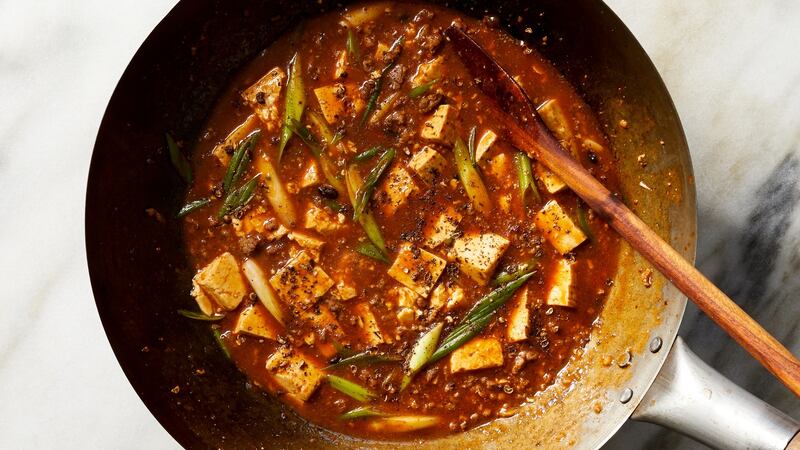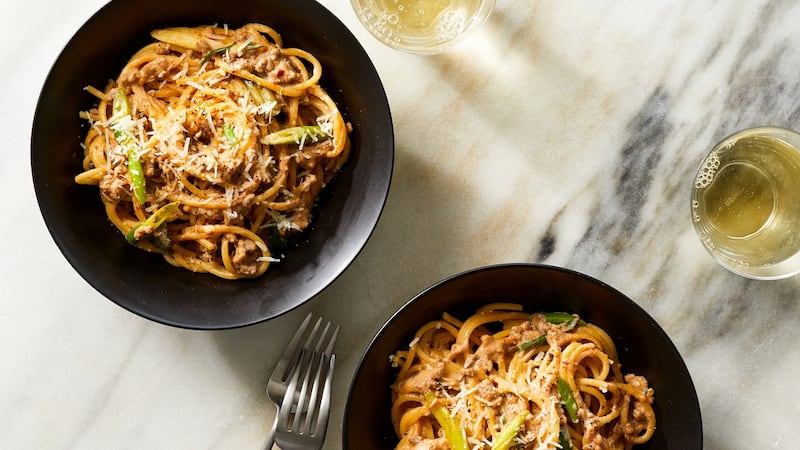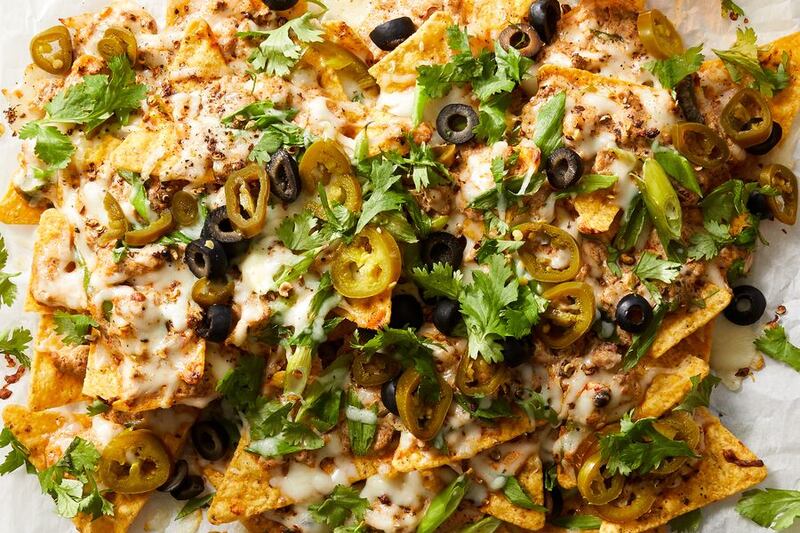Anyone who says tofu is bland or boring hasn't eaten mapo tofu, the intoxicatingly spicy, fragrant dish from the Sichuan province of China.
Unlike the gentle Vietnamese tofu dishes I grew up with in Southern California, "mapo," as some casually refer to it, first captured my attention as a teenager in the early 1980s, when my dad and his buddy - whom we always reverently called Mr Lee - let me tag along for lunch at a Chinese restaurant. As the adults talked, I ate as much of the tender tofu cubes and piquant meat sauce as I could without seeming piggish.
More than smitten, I became fascinated with the slithery brow-wiper, going on to research it in library books as a youth, traveling to Chengdu (the capital of Sichuan province and the dish's birthplace) to understand its origins, and later experimenting with it in my own kitchen.
Mapo tofu is sometimes translated as "pockmarked old woman's bean curd." (In Chinese, "ma" refers to pockmarks, and "po" can refer to an older woman.) The name is an inelegant nod to the smallpox-scarred skin of Mrs Chen, who is said to have invented the dish in the late 1800s at her family's restaurant in northern Chengdu.
As the story goes, porters lugging oil to market would frequent her establishment, and one day, they requested an affordable dish made of tofu and meat cooked up with some of the oil they transported. Mrs Chen seasoned her creation with Sichuan staples, and it became a hit, its popularity only growing over time.
When I finally visited Chengdu in 2010, decades after my first taste of mapo tofu, I knew I wanted to try a version as close to Mrs Chen’s as possible. Her restaurant no longer exists in its original form, but I headed to Chen Mapo Tofu, hoping that its recipe truly descended from her as some have claimed. My travel companions and I sat at the restaurant, eagerly awaiting bona fide mapo tofu, and it finally appeared, the tofu and nubbins of meat under a thick layer of fiery red oil and lots of huajiao, or tingly Sichuan peppercorn. But, surprisingly, it lacked the savory depth I had expected from its central seasoning, a fermented chilli bean paste known as doubanjiang.
To deepen my understanding of doubanjiang, I checked in with Yu Bo, an internationally respected Sichuan chef, based in Chengdu, who organized a visit to a centuries-old producer in Pixian, a suburb of Chengdu. There, in a walled facility the size of a baseball diamond, were rows of large, lidded urns filled with heady chiles and broad beans fermenting in the sun. I peered inside and inhaled the coarse, dark-red mixture, pondering my next mapo.
I hit pay dirt when Zhong Yi, a graduate student at Sichuan University, invited me and my companions to her family's Mid-Autumn Festival celebration. Her grandmother presided over the activities, quietly tasting and tweaking as everyone scrambled around the kitchen. The family made a dozen dishes, including a mapo tofu that wasn't as oily or fiery as Chen Mapo Tofu's.
They had also cooked extra beef seasoned with doubanjiang and mapo’s other ingredients - everything but the tofu - and, toward the end of the meal, Zhong Yi’s aunt made a 13th dish by spooning the beef atop angel-hair-like wheat noodles and gleefully presenting it as “fast dan dan noodles.” That playful gesture was a lasting lesson in mapo tofu’s potential.
For the past 10 years, I’ve thought about the family’s improvisation and mapo’s culinary elasticity, but, not being of Chinese heritage and lacking a strong connection to Sichuan, I didn’t stray from the conventional recipe that was a solid part of my repertoire.

Then, last year, I tried a mapo tofu lasagne from the chef Mei Lin at Nightshade in Los Angeles and read about Yu Bo's mapo tofu with avocado. Only then did I feel free to experiment. I whizzed up a tub of silken tofu, then simmered it for a few minutes alongside the fermented ingredients. Together, they became a creamy sauce that expressed mapo's essence in a slightly mellower form. It was perfect for spaghetti.
Still, there was leftover sauce. Its funky spiciness inspired queso-like ideas, so I served it with tortilla chips. The chip’s crunch complemented mapo tofu’s boldness well. Eventually, I used the sauce for superb mapo nachos, which I embellished with melty cheese, pickled jalapeños, olives and coriander.
Who would have thought that such a simple dish could spur a nearly 40-year fascination, dare I say obsession? Mapo tofu had me at first bite, and, while I will always appreciate its roots, tinkering has proved so delicious.

Mapo tofu
Serves four
Ingredients
450g medium or medium-firm tofu (if unavailable, go with firm)
1 rounded teaspoon Sichuan peppercorns
3 tablespoons canola oil
170g ground beef or pork (preferably 80% or 85% lean), roughly chopped to loosen
2½ to 3 tablespoons doubanjiang (fermented chilli bean sauce or paste)
1 tablespoon douchi (fermented black beans, optional)
1 teaspoon minced fresh ginger
½ teaspoon red-pepper flakes (optional)
2 teaspoons regular soy sauce
1 rounded teaspoon sugar, plus more if needed
Fine sea salt
2 large spring onions, trimmed and cut on a sharp bias into thin, 2-inch-long pieces
1½ tablespoons cornstarch dissolved in 3 tablespoons water
Cooked white rice, for serving
Method
1. Prepare the tofu: Cut the tofu into ¾-inch cubes and put into a bowl. Bring a kettle of water to a rolling boil. Turn off the heat and when the boiling subsides, pour hot water over the tofu to cover. Set aside for 15 minutes.
2. Meanwhile, in a large (14-inch) wok or (12-inch) frying pan over medium heat, toast the peppercorns for 2 to 3 minutes, until super fragrant and slightly darkened. (A wisp of smoke is normal.) Let cool briefly, then pound with a mortar and pestle, or pulse in a spice grinder.
3. Set a strainer over a measuring cup, then add the tofu to drain; reserve 1½ cups of the soaking water, discarding the rest. Set the tofu and reserved soaking water near the stove with the peppercorns and other prepped ingredients for swift cooking.
4. Reheat the wok or pan over high heat. When hot - you can flick water in and it should sizzle and evaporate within seconds - swirl in the oil to evenly coat, then add the meat. Stir and mash into cooked and crumbly pieces, 1 to 2 minutes.
5. Add 2½ tablespoons doubanjiang, the douchi (if using), ginger and red-pepper flakes (if using). Cook about 2 minutes longer, stirring constantly, until things are vivid reddish brown. Add the soy sauce and sugar, stir to combine, then add the tofu. Gently stir or shake the pan to combine the ingredients without breaking up the tofu much.
6. Add the reserved 1½ cups soaking water, bring to a vigorous simmer and cook for about 3 minutes, agitating the pan occasionally, to let the tofu absorb the flavors of the sauce.
7. Slightly lower the heat and taste the sauce. If needed, add the remaining ½ tablespoon of doubanjiang for heat, a pinch of salt for savouriness or a sprinkle of sugar to tame heat.
8. Add the scallions and stir to combine. Stir in the cornstarch slurry, then stir in enough to the mapo tofu to thicken to a soupy rather than a gravylike finish. Sprinkle in the ground peppercorns, give the mixture one last stir to incorporate, then transfer to a shallow bowl. Serve immediately with lots of hot rice.

Mapo tofu spaghetti
Serves four
Ingredients
1 tablespoon fine sea salt
340g dried spaghetti
2 ½ cups mapo tofu sauce (see recipe above)
1 large spring onion, trimmed and cut on a sharp bias into 2-inch-long pieces
2 to 3 tablespoons grated Parmesan
Method
1. Fill a large pot about halfway with water and add no more than 1 tablespoon salt to lightly season. Bring to a boil over high heat, then add the spaghetti and boil until al dente according to package instructions. Ladle out about ¾ cup of the pasta cooking water, then drain the spaghetti. Briefly rinse to remove some of the starch and shake to expel excess water.
2. In the same pot (or a clean large skillet, if you wish), warm the mapo tofu sauce and ⅓ cup of the reserved pasta cooking water over medium heat. When hot and bubbling, add the spaghetti to the sauce. Use tongs to stir and coat the strands. Stir in extra pasta water by the tablespoon for a creamier, silkier finish, if desired.
3. Stir in the spring onion and cook very briefly until just softened. Divide the pasta among plates or shallow bowls and serve topped with cheese and Sichuan peppercorns.

Mapo tofu nachos
Serves four
Ingredients
I large bag corn tortilla chips
About 1¼ cups mapo tofu sauce (see recipe above), at room temperature
2 medium scallions, trimmed and sliced on the bias into ¾-inch-long pieces
120g grated mild-flavored melty cheese
Sliced or coarsely chopped pitted olives, such as black, green or a combination (optional)
2 whole pickled jalapeños, sliced (optional)
Coarsely chopped coriander (optional)
Method
1. Prepare the nachos: Heat an oven to 180 degrees Celsius. Line a baking tray with parchment or aluminum foil, leaving a little overhang on two sides so you may later easily transfer the nachos. Arrange half of the chips on the pan, laying them flat. (Some overlap is fine.)
2. Use a spoon to strew half the mapo tofu sauce onto the chips. Sprinkle with half the scallions, cheese and Sichuan peppercorns. Repeat with the remaining chips, sauce, scallions, cheese and peppercorns.
3. Bake for 8 to 10 minutes, until the cheese completely melts and there is gentle sizzling. Remove from the oven, lift the parchment paper or foil to remove the nachos from the pan, then use a spatula to carefully usher the nachos to a platter. Top with any combination of olives, pickled jalapeños and cilantro, if desired. - New York Times.











